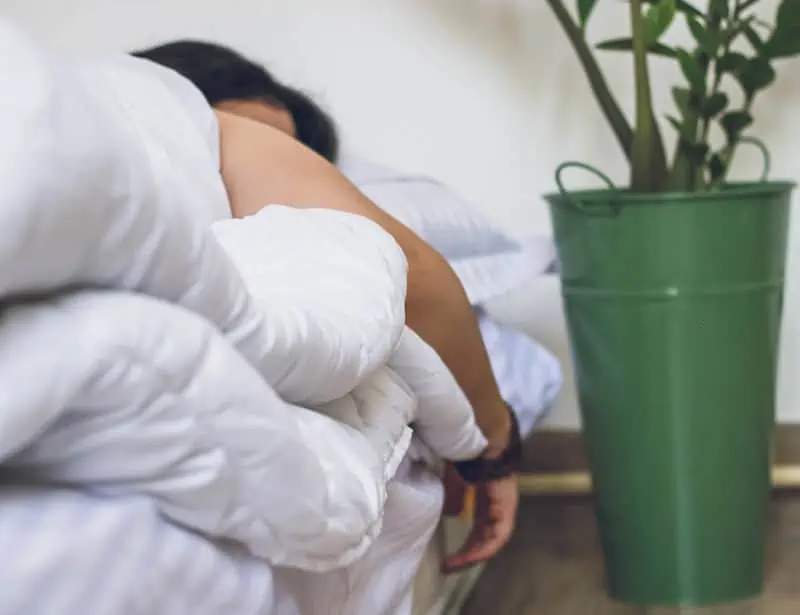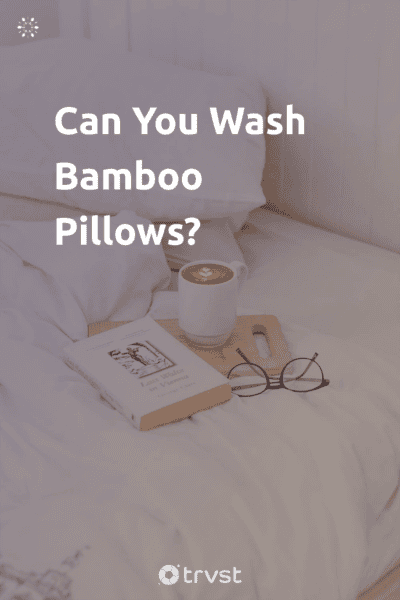Can You Wash Bamboo Pillows?
Choosing a bamboo pillow comes with benefits that include a reduced carbon footprint. But how do you take proper care of it? The National Sleep Foundation recommends washing your pillows every six months for the one or two years they should last. But can you wash bamboo pillows? And if you can, how do you do it? Here are all the answers you need if you're wondering how to wash bamboo pillows.
What is a bamboo pillow?
Bamboo is a fast-growing plant that has proved useful in diverse industries. Manufacturers have used it to produce building materials, paper, clothing, and even pillows. They do not make the entire pillow out of bamboo; the casing or removable cover and pillowcase are made from bamboo fiber. The pillow filling is usually solid or shredded memory foam.
Therefore, a bamboo pillow is simply a pillow with a bamboo cover made from bamboo fabric woven from bamboo fiber.
Related: For more eco-friendly sleep options, check out our rundown of the best bamboo mattresses, also blending sustainable bamboo for improved sustainability.
Benefits of bamboo pillows
A good night's sleep is essential for the health and well-being of any individual. Pillows make sleeping more comfortable by keeping your head and spine aligned. Choosing the correct pillow to suit your body's needs is important to enjoy the benefits. The wrong pillow can cause or aggravate sleep problems.
There are many advantages to grabbing a new bamboo pillow, and most of the benefits come from the fiber of this great material.
Note that there are eco-friendly and not-so-eco-friendly bamboo fabrics. Bamboo linen and lyocell are considered more environmentally sustainable than bamboo viscose rayon. The following are some advantages of using bamboo pillows.
Adjustable
Many bamboo pillows allow personalized adjustment to enhance comfort. So, regardless of the sleeping positions you favor, the bamboo pillow will provide just the right support to help you get better sleep. All you need to do is remove some pieces of the shredded memory foam filling or add to it to suit your needs.
They design some bamboo pillows so that folding them in half, laying them flat, or on their side gives different kinds of support.
Moisture-wicking
Bamboo fiber has a natural moisture-wicking quality that keeps you dry and cool even when it's hot. Bamboo fibers can do this because of their makeup's micro holes and gaps that create air pockets. Researchers suggest that the loose structure of the bamboo fiber gives it a larger moisture-wicking capacity1 compared to other natural fibers like cotton.
If you sweat a lot, the absorption power of bamboo may help you feel completely dry. This will help you sleep better.
Hypoallergenic and antibacterial
Bamboo fiber has hypoallergenic qualities, which makes it safe for people with sensitive skin. The bamboo fiber is sterile due to the presence of the bio-agent bamboo chinone. It is called 'Kun' in Japanese. The bio-agent helps the plant to fight bacteria.
Thanks to their antibacterial quality, bamboo pillowcases, and bamboo bedding are more resistant to odor, so they stay fresh longer.
Soft and Durable
Bamboo fiber is softer than cotton and feels silky to the touch with a lustrous appearance. It is also static-free and will not cling to your skin. A bamboo pillow cover is breathable and as strong as cotton. It is resilient and will go through machine wash unless the manufacturers indicate otherwise.
Eco-friendly
Bamboo is a renewable resource. Its cultivation is not labor-intensive as the plant spreads through a rhizome root structure that is not affected during harvest. Bamboo farming is not water or pesticide and herbicide intensive, which makes it compare favorably to cotton.
Farmers can sustainably harvest bamboo every 3-5 years without destroying soil structure.
How to wash a bamboo pillow

Washing a bamboo pillow properly is important to eliminate grime and dust mites they may have collected over time. A brand new pillow would probably come with washing instructions, but if you buy second-hand as we often recommend, you may need to figure it out yourself.
A clean pillow is essential for good sleep, and below are the processes, dos, and don'ts of washing bamboo pillows.
Washing the pillowcase
You should remove the pillowcase and wash it with a load of laundry, preferably other soft beddings. Be sure to wash dark and light colors separately to avoid discoloration and stains. If the bamboo pillowcase has buttons or a zipper, fix it before it goes into the washing machine.
If the pillow case's care instructions do not specify hot or cold water, use neither, as they may severely damage the fabric. Use warm water and a mild or gentle detergent, and let it wash on a gentle cycle. You may air dry the pillowcase but if you use a dryer, make sure the dryer is at a low heat setting.
Another way to clean your bamboo pillow cover is to hand wash it. You can do this in a hand wash basin or a deep sink. Consider your safety first, and keep the water temperature at a degree that is gentle on your skin.
Washing the memory foam
Your bamboo pillow could have a solid or shredded memory foam filling. This can influence what washing method is best for you. More often, pillows should be hand-washed because it is gentler on the fabric. Whether you choose to wash bamboo pillows by hand or use a washing machine, always use warm water.
For hand washing, use your sink; if it is not large enough to contain the pillow, try a tub. Lukewarm water is best for hand-washing bamboo pillows and won't hurt your hands. Spread the soap all over the submerged bamboo pillow and massage it into the pillow. Try squeezing the pillow like a sponge a couple of times to get the soap into the whole pillow.
To rinse, wring out as much soapy water as possible and then rinse until the suds subside.
For machine-washed pillows, set the washing machine to run a gentle wash or delicate cycle.
Use a gentle detergent
Do not use harsh detergent to wash a bamboo pillow. Harsh detergents can damage the fiber of the bamboo pillow so use a mild or gentle detergent. You mustn't use too much soap. This is because regular memory foam is highly absorbent and will retain soapiness for much longer, making it difficult to rinse clean.
Also, do not use fabric conditioners or bleach to keep your bamboo pillow clean. These products can damage the fiber and reduce its moisture-wicking quality.
Drying
Dry bamboo pillows by placing them on a clean flat surface or hanging them on a clothesline with a pillow hanger. Air drying can help retain the memory foam's quality for longer.
After you wash a bamboo pillow, try not to use a dryer as the dryer heat may ruin the memory foam. This is very important if you are drying a single pillow. However, if you can not let the pillow air dry and must use a dryer, place a few tennis balls to help keep the pillow in good shape.
Allow the bamboo pillows to completely dry; using a wet pillow will invite mold and mildew. Your pillow might also acquire an unpleasant smell if you use it when it's still damp.
Ironing
When ironing your bamboo pillowcase or bamboo mattress toppers, use the pressing iron on low heat. This is important because excessive heat can reduce the durability of bamboo fiber.
Proper storage of bamboo memory foam pillow
It is not enough to wash pillows or beddings; you also need to store them properly.
Below are a few tips for storing bamboo pillows and beddings correctly.
Avoid heat
Heat can damage the bamboo fiber. So do not keep the pillows in vacuum-sealed bags or plastic because heat and moisture can build up inside. Closets or cabinets placed near a water heater, radiator, heat vent, or any heat source are not suitable storage for bamboo pillows.
Don't wash new bamboo pillows
Newly purchased bamboo pillows may have a gassing-off smell that may be a little offensive. However, you should not wash the pillow immediately just to get rid of the smell. Washing wears out the fabric over time, and you should avoid unnecessary laundering.
Rather than wash it, air out the bamboo pillow for a few hours or a day. The natural bamboo odor will fade within that period.
Use gentle stain removers
Heavy-duty detergents or chlorine bleach can damage fiber structure. Therefore you should use gentle or natural alternatives to get rid of stains and brighten bamboo beddings. You can pretreat stains on bamboo covers before washing to get optimal results.
Small amounts of oxygen bleach, vinegar, and baking soda can help get rid of stains. To disinfect the bamboo pillow, use pine oil or white vinegar.
Conclusion
Can you wash bamboo pillows? The answer is yes. You can wash bamboo memory foam pillows and not just the pillowcase but the whole pillow. All you need is warm water and a mild detergent to get yourself a clean bamboo pillow.
| 1 | Nayak, L., Mishra, S.P. (2016). Prospect of bamboo as a renewable textile fibre, historical overview, labeling, controversies and regulation. Fash Text 3, 2 (2016). https://doi.org/10.1186/s40691-015-0054-5 |
Jen’s a passionate environmentalist and sustainability expert. With a science degree from Babcock University Jen loves applying her research skills to craft editorial that connects with our global changemaker and readership audiences centered around topics including zero waste, sustainability, climate change, and biodiversity.
Elsewhere Jen’s interests include the role that future technology and data have in helping us solve some of the planet’s biggest challenges.

